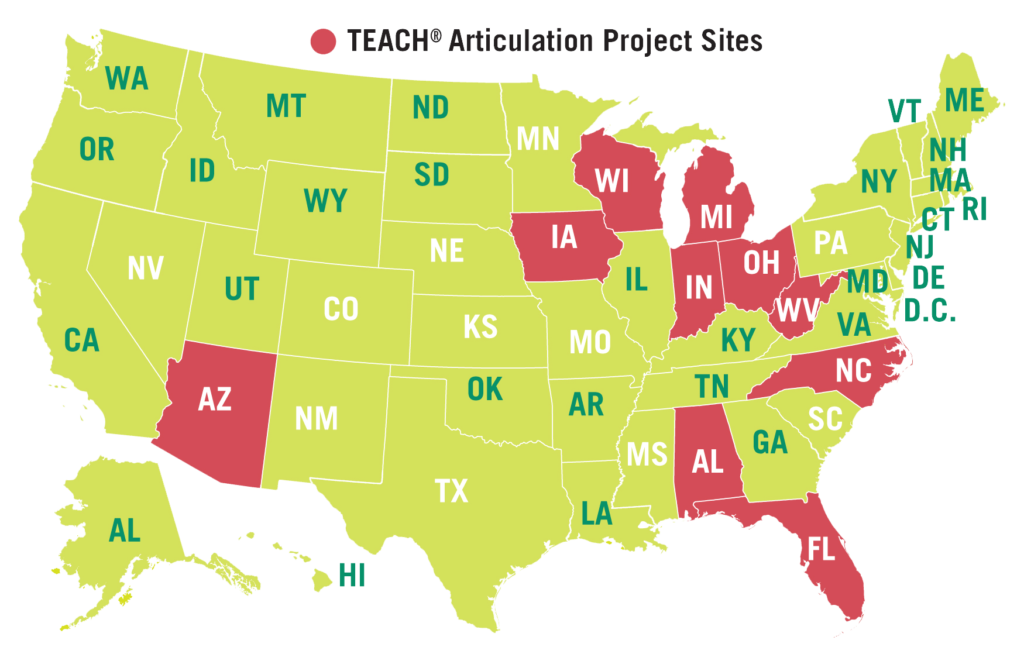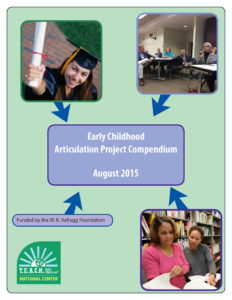Early Childhood Articulation Project Compendium
A core value of T.E.A.C.H. is for the workforce to have access to coursework with currency, meaning all college credits articulate between and among all higher education institutions within a state. One of the thorniest issues facing the early education workforce in their efforts to earn degrees is the lack of an articulated pathway from the associate degree to the bachelor’s degree. Having a transparent and easily accessible education pathway for the workforce is key to student success, but for any number of reasons, states struggle to create smooth pathways. To strengthen our work around access to higher education, the National Center worked with 10 T.E.A.C.H. state teams to increase the effectiveness, strength and number of articulation strategies within those states.
Project Goal
Participating states improved articulation of college coursework and degrees from two-year institutions of higher education to four-year institutions in the state by identifying and implementing various strategies that either directly or indirectly affected the intended goal.
Strategies Employed to Advance Articulation Efforts
- Building relationships with key partners
- Developing common course curriculum
- Improving practicum and fieldwork options
- Analyzing costs
- Leveraging resources
- Forming articulation agreements
T.E.A.C.H. Early Childhood® States who Participated in the Articulation Project

Articulation Components
Oversight and Evaluation includes
- State structure for system wide articulation; and/or legislated mandates
- Committees within systems and institutions to accomplish articulation
- State private and public, on campus and online participation of stand-alone institutions and systems
- An expectation for meaningful articulation agreements
- Monitoring and review of agreements on a regular schedule
- Evaluation of agreements
- Appeals Processes
Student Focused Approach includes
- A receptive culture for transfer students equivalent to “native” students
- Advising and counseling service centers
- Transfer Guides that support transparency
- Guarantees for agreed upon transfers
- Common student records
- On line information systems for students and families
- Transparent appeals process
Faculty Interactions require
- Expected and recognized faculty interaction
- Completed agreements on articulation
- Allocated time and resources for faculty efforts
- Collegial engagement of faculty with counterparts
Transfer Content acknowledges
- Expectation of academic rigor at all levels of the system
- Overall competency proficiency, not course by course
- Wastefulness of duplicated coursework time and resources
- Third party validation including accreditation, state approved common course catalogues/ state approved competencies, national approval systems
- Alternative strategies for completion of field base requirements
- Recognition that knowledge base is constantly changing, requiring continuous improvement with regular updates
- Academic preparation for employment and career attainment
Articulation Resources
Documents
- The Early Childhood Articulation Project Compendium
- Articulation Principles and Elements
- Higher Education Checklist
- Transfer Guides for Student Focused Articulation
Articulation Webinars
- Building ECE Career Pathways -The Challenge of Compensation (Full Webinar Recording) Feb 2017
- Building ECE Career Pathways – The Development of a Scholar (Full Webinar Recording) Dec 2016
- Building ECE Career Pathways – The Role of Accreditation (Webinar Recording) Nov 2016
- Building Student Focused ECE Career Pathways (Full Webinar Recording) Sept 2016
- High Schools – A Staff Pipeline for ECE (Full Webinar Recording) August 2016
- Accreditation: A Strategic Link for Articulation (PDF) December 2013.
- Hosted and presented through a cooperative effort of the T.E.A.C.H. Early Childhood® National Center and the National Association for the Education of Young Children (NAEYC). Marica Cox Mitchell, Deputy Executive Director at NAEYC, presented with assistance from Jessica A Cooper, M.S, Alamo Colleges: St Phillip’s College, and Pamela Evanshen, Claudius G. Clemmer College of Education, East Tennessee University
- Articulation Made Easy: Using Transfer Guides to Support Student Success (Full Webinar Recording)
- Hosted and presented through a cooperative effort of the T.E.A.C.H. Early Childhood® National Center, the University of Cincinnati, and Stark State College. Presented by Jennifer Jacobs, University of Cincinnati and Danette Lund, Stark State College
- Moving the Needle on Articulation: Progress from a Ten State Project (Full Webinar Recording) May 2015
